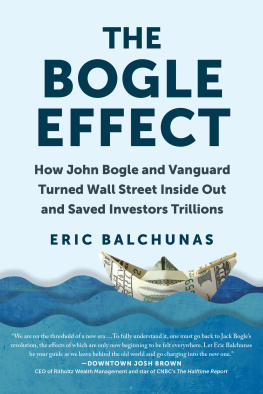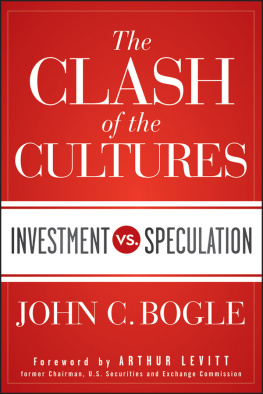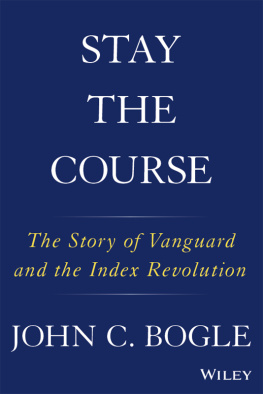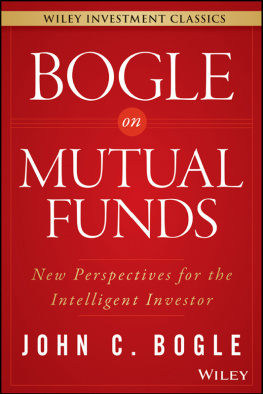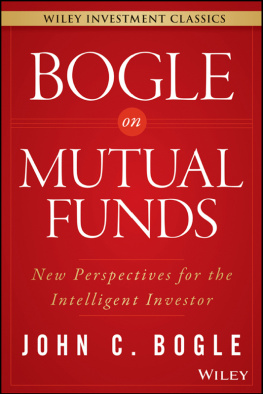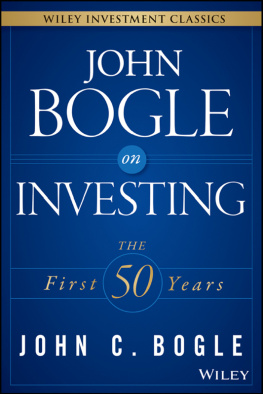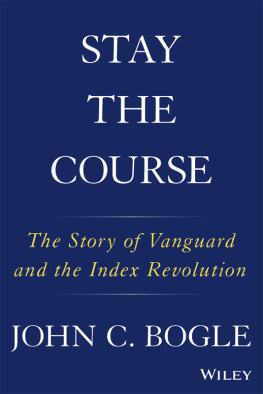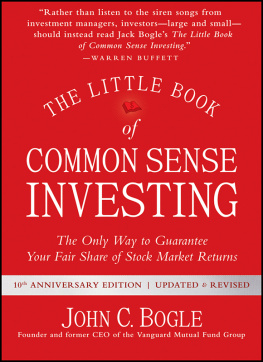The HOUSE that BOGLE BUILT
How John Bogle and Vanguard Reinvented the Mutual Fund Industry
LEWIS BRAHAM


Copyright 2011 by Lewis Braham. All rights reserved. Except as permitted under the United States Copyright Act of 1976, no part of this publication may be reproduced or distributed in any form or by any means, or stored in a database or retrieval system, without the prior written permission of the publisher.
ISBN: 978-0-07-175115-5
MHID: 0-07-175115-7
The material in this eBook also appears in the print version of this title: ISBN: 978-0-07-174906-0, MHID: 0-07-174906-3.
All trademarks are trademarks of their respective owners. Rather than put a trademark symbol after every occurrence of a trademarked name, we use names in an editorial fashion only, and to the benefit of the trademark owner, with no intention of infringement of the trademark. Where such designations appear in this book, they have been printed with initial caps.
McGraw-Hill eBooks are available at special quantity discounts to use as premiums and sales promotions, or for use in corporate training programs. To contact a representative please e-mail us at bulksales@mcgraw-hill.com.
This publication is designed to provide accurate and authoritative information in regard to the subject matter covered. It is sold with the understanding that neither the author nor the publisher is engaged in rendering legal, accounting, securities trading, or other professional services. If legal advice or other expert assistance is required, the services of a competent professional person should be sought.
From a Declaration of Principles Jointly Adopted by a Committee of the American Bar Association and a Committee of Publishers and Associations
TERMS OF USE
This is a copyrighted work and The McGraw-Hill Companies, Inc. (McGraw-Hill) and its licensors reserve all rights in and to the work. Use of this work is subject to these terms. Except as permitted under the Copyright Act of 1976 and the right to store and retrieve one copy of the work, you may not decompile, disassemble, reverse engineer, reproduce, modify, create derivative works based upon, transmit, distribute, disseminate, sell, publish or sublicense the work or any part of it without McGraw-Hills prior consent. You may use the work for your own noncommercial and personal use; any other use of the work is strictly prohibited. Your right to use the work may be terminated if you fail to comply with these terms.
THE WORK IS PROVIDED AS IS. McGRAW-HILL AND ITS LICENSORS MAKE NO GUARANTEES OR WARRANTIES AS TO THE ACCURACY, ADEQUACY OR COMPLETENESS OF OR RESULTS TO BE OBTAINED FROM USING THE WORK, INCLUDING ANY INFORMATION THAT CAN BE ACCESSED THROUGH THE WORK VIA HYPERLINK OR OTHERWISE, AND EXPRESSLY DISCLAIM ANY WARRANTY, EXPRESS OR IMPLIED, INCLUDING BUT NOT LIMITED TO IMPLIED WARRANTIES OF MERCHANTABILITY OR FITNESS FOR A PARTICULAR PURPOSE. McGraw-Hill and its licensors do not warrant or guarantee that the functions contained in the work will meet your requirements or that its operation will be uninterrupted or error free. Neither McGraw-Hill nor its licensors shall be liable to you or anyone else for any inaccuracy, error or omission, regardless of cause, in the work or for any damages resulting there from. McGraw-Hill has no responsibility for the content of any information accessed through the work. Under no circumstances shall McGraw-Hill and/or its licensors be liable for any indirect, incidental, special, punitive, consequential or similar damages that result from the use of or inability to use the work, even if any of them has been advised of the possibility of such damages. This limitation of liability shall apply to any claim or cause whatsoever whether such claim or cause arises in contract, tort or otherwise.
To my wife and family
we are without beginning or end.
CONTENTS
PREFACE
I first met Jack Bogle in November of 2009 at his office in Malvern, Pennsylvania. Id seen the founder of Vanguard Funds before on television a few times and heard him talk once at a conference, but I had never actually spoken to him face to face. So I was nervous.
It isnt often in this life one gets to meet a legend. And I knew that as Bogles biographer, I would have to say some unpleasant things about him, that part of my unenviable job would be to see the clay in the heros feet. Whats more, the greatest advocate of shareholder democracy in the history of Wall Street was known for his autocratic personality and intolerance of dissent.
This, after all, was the same man who in his The Battle for the Soul of Capitalism railed against a system of dictatorship in corporate America... in which the power of the CEO seems virtually unfettered, and yet, during our first interview at Vanguard, told me, If someone says when I was running this place, I was a dictator, I would say, man, youve got that right!
Of course, I was also intrigued. A complicated soul who often contradicts himself, Bogle embodies that much abused and overused term maverick. In many ways he resembles my late father. Both grew up in the shadow of the Great Depression to Scottish American families. Both were born well-off and then lost it all. Both had fathers who were absent, and as a result had to become men when they were much too young. Im not going to make any exaggerated claims that Jack Bogle cest moi. My father never had the opportunity to go to the Blair Academy or to Princeton. Nor did he launch the worlds largest mutual fund company.
Yet the similarities were enough to pique my interest and terrify me at the same time. As it turned out, my journey to Malvern put me in the right mood to meet the king of the penny-pinching fund companies, as I didnt have much of a kitty for travel expenses. Consequently, I had to take a seven-hour Amtrak train from my home in Pittsburgh instead of a plane. I later told Jack I was living the Vanguard way.
Roaring through the blighted hinterlands of Pittsburgh on a gray, drizzly day with my Dell Precision M4300 and a stack of articles about Bogle balanced precariously on my lap, I couldnt help feeling like Marlowe going after Kurtz in the Congo, hoping to find a voice of reason in the dark heart of Wall Street, yet dreading that, when I finally reached Bogle, hed just gasp, The horror, the horror!
Since no train goes all the way to Malvern and I couldnt afford a taxi, my in-laws, who live nearby, had to give me a lift from the Exton station. The long, tortuous drive through multiple checkpoints onto the Vanguard campus did little to assuage my nerves. At the end of a tree-lined Vanguard Boulevard, the campus felt more like a remote military compound than the collegial edifice of financial wisdom the company would have investors believe. Although Vanguard houses none of its $1.4 trillion in assets here, its guards recently started carrying guns just in caseof what Im not exactly sure. They seemed out of place in a region of Pennsylvania known more for its Amish whoopie pies and giant King of Prussia shopping mall.
Bogle is no longer in the C-suite after being forced to retire as Vanguards chairman in 1999. His office as the titular president of the Bogle Financial Research Center is now on the same floor as the legal department of what can only ironically be called the Victory Building. It overlooks the main square of the Vanguard campus and a bronze statue of him. I guess in certain ways I like this much better, he says, smiling uncomfortably. Instead of overlooking the parking lot, I am overlooking this place out there. I can see my statue over there. I can see the crew members walking back and forth. I feel much more a part of things.


